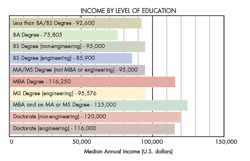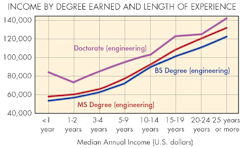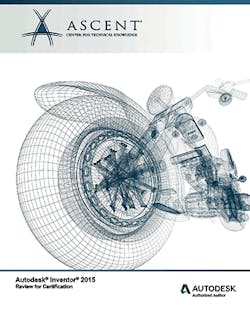The Value of a Continuing Engineering Education
This file type includes high resolution graphics and schematics when applicable.
Many engineers start out in the industry with only a bachelor’s degree to their name. This is a rarity in the world of major science professions, as most advanced professions require further education before you can enter that field. Doctors and research scientists, to give two examples, require post-bachelor studies (i.e., doctorate or master’s degree, thesis statement), certifications, or a state license to work in those professions.
Engineering graduates are an exception to the rule. Many engineers enter the industry straight from college after achieving their bachelor’s degree, and not all engineers require a professional engineering license. Licensing for engineers is typically dependent on the type of field one enters, and many can go their entire careers without obtaining one.
However, continuing education is an important and growing concern for many of today’s engineers. Machine Design’s 2015 Salary Survey showed that the majority of our readers (35.7%) have a bachelor’s degree. The next largest group was 22.4% with a master’s degree. Both groups were primarily comprised of engineers over the age of 50-60.6% with a bachelor’s degree and 72.1% with a master’s degree. As the workforce for engineers continues to age, it is important for engineers to stay in the loop with the latest engineering developments.
Our 2015 Salary Survey listed “staying current with modern technology” as the third-highest concern among engineers, at 28%. There is also higher pressure today for current young engineers to obtain higher degrees from the start. The latest statistics show that the more education one obtains throughout their career the higher income, and job status is possible. Fortunately, there are several methods today’s engineer can employ to receive the education and training necessary to stay in the game.
Education and Experience among Working Engineers
Occupations in the science and engineering (S&E) fields have been on the rise since the 1960s. According to the National Science Board in its Science & Engineering Indicators 2016 Report, S&E occupations grew from 1.1 million in the 1960s to 6.2 million in 2013. That is an annual growth rate of 3% compared to a 2% growth rate in total employment for the same time period. In 2013 and 2014, 27.2% of people employed in S&E jobs were in engineering fields and have a bachelor’s degree or higher.
The percentage growth in engineering occupations from 2003 have risen 1.8% for professionals with a bachelor’s degree, 2.6% with a master’s degree, and 3.1% with a doctorate. Of the students coming out of school in 2013, 21.1% had a bachelor’s, 24.6% had a master’s, and 18.6% had a doctorate in engineering, according to the National Science Board.
The trend shows that the more you have invested in your engineering education, the more likelihood you will work in that field. In 2013, 40.7% of professionals with at least a bachelor’s degree are in engineering work within a field of said degree. The percentage of engineering degree-holders employed in engineering occupations is 77.1% for engineering doctorates, 62.5% for engineering masters, and 52.9% for engineering bachelors. Engineers with a bachelor’s degree are the largest group out of the other S&E occupations. Bachelor’s in computer and math sciences are second at 50.4% and the physical sciences come in third at 35.8%.
The Science & Engineering Indicators 2016 Report also states that 27.5% work in non-related engineering fields, but the majority of those workers report that their “work is related to their S&E training, suggesting that the application of S&E skills and expertise extends well beyond jobs formally classified as S&E occupations.” Managerial jobs are an example of this.
It is also important to note that we have an aging workforce with many skilled workers retiring soon. According the World Bank, one third of North America’s workers are over 50 years old and by 2020 more than 115 million skilled workers will have retired or be near the retirement age of 65. The European Union, China, and Latin America are seeing similar problems in their skilled workforce, as well.
The Benefits from Continuing Education
With the statistics listed above, we can start to analyze why continuing education is beneficial. The numbers show that there is a growing field of engineers with a master’s degree or higher. This holds especially true if one wants to continue in engineering. The more education one obtains, the better income they will obtain. According to a salary survey done by the American Society of Mechanical Engineers (ASME) in 2012, full-time salaried engineering employees with a doctoral degree earned a median income of $116,000. Compared to those full-time employees with a master’s or bachelor’s, the median income was $95,576 and $85,900 respectively.
These numbers also lined up with Machine Design’s Annual Salary Survey from last year that reported engineers with a master’s degree making an average of $105,616 and engineers with a bachelor’s degree an average salary of $89,620. Engineers with a doctorate in engineering versus a bachelor in engineering earn a median of 35% more.
The pattern of higher education producing a higher income is even true when you account for length of experience. Engineers with a bachelor’s degree and 20-24 years of experience made a median income of $110,000 and $122,000 with over 25 years of experience. Engineers that had a master’s degree made a median of $120,000 for 20-24 years and $131,000 for over 25 years of experience. Lastly, engineering doctorates made a median of $124,750 and $140,500 for experience ranging from 20-24 and over 25 years, respectively.
Continuing education is not limited to just obtaining more degrees, but also licensing and certification. For engineers, having a license makes you a Professional Engineer (PE). Engineering students graduating from college are encouraged to take the Fundamental Engineering (FE) exam. Once they have obtained experience (at least four years) under an already licensed PE and have passed the FE, they can apply to take the Professional Engineering exam to earn a license under their state’s licensure board.
Being a PE allows engineers to prepare, sign and seal, and submit engineering plans and drawings to a public authority for approval for work on public and private projects. According to the salary survey from ASME, the median salary for a PE is $100,500 and the median salary for a non-licensed engineer is $95,775. And licenses vary, so there are subsets of PEs. By having a PE license in an engineering specialty, the median salary jumps to $110,300. For example, a license in environmental engineering provides a median salary of $113,000.
For those considering obtaining a PE license, the decision of returning to school might become a necessity. An effort is being put forth by the American Society of Civil Engineers (ASCE) to raise the minimum requirement for PE licensing to a master’s degree or an additional 30 credit of graduate or upper level undergraduate coursework. The movement is being called “Raise the Bar."
The ASCE believes that an undergrad degree is no longer enough to prepare engineers for the future. This movement has yet to become official but is supported by many engineers within the industry. Considering how many engineers are graduating with a master’s degree, it may only be a matter of time before it becomes effective.
The benefits of continuing education benefit both the employee and the employer. The study “Measuring the Benefits of Continuing Engineering Education” by Amy C. Prevost, graduate assistant, and Philip R. O’Leary, chair of the Engineering Professional Development (EPD) department, at the University of Wisconsin-Madison states that continuing education is an important part of the engineering profession in the 21st Century.
According to their study, engineers will assume a prominent role as future leaders of inter-disciplinary teams focusing on the new technological developments. “Education must respond to the new reality of globalization, the information revolution, sustainable development, lifelong learning, and gender equality,” it says. Prevost and O’Leary conducted a research survey on two groups taking training in EPD courses: storm sewer/culvert design and ammonia refrigeration. They concluded that 93% of the participants saw the training as useful towards their current job, and that 54% would see direct savings in either cost or labor because of their training.
The study concludes that many of the effects from continuing education cannot be measured. For example, employees feel more satisfied and secure in their knowledge. Continuing education provides career maintenance and helps prevent obsolescence as our current technology becomes more complex, requiring interdisciplinary skills. An engineer who learned how to code PLCs 20 years ago will now need training on how to program modern PLCs that have touchscreen displays, based on JAVA script, and have Ethernet capabilities.
Lastly, one of the main reasons to return to school and receive more education is to stay with the current tide of engineers entering the field. For employers, by helping engineers stay update to with current technology they help extend the usefulness of their senior engineers and makes their labor force more efficient. An educated staff will lead to time, cost, and labor savings. According to the study, a 10% investment of training expenditures provides a 1.0-1.2% increase in labor productivity.
For the engineer looking to move ahead, continuing education is also beneficial for networking and career changes. Many engineers switch jobs and even industries. Having higher degrees or different certifications can provide job mobility within ones current job or transfer to new settings. A PE engineer working in HVAC can look for new opportunities in the construction markets since many drawings used for building plans require a PE’s signature and approval. By placing yourselves in new and different educational settings, networking outside of your industry is easier.
How to Pursue Continuing Education
We return to the main problem many engineers face when trying to pursue new educational opportunities: time. Approximately 70% of salary survey respondents reported working more than 40 hours a week, with about 7% working from home.
For PEs, each state has a minimum number of continuing education credits per year. The amounts can vary from none, to 15 or 30 hours of credit courses. Societies require a minimum credit to continue being a member. The National Council of Examiners for Engineering and Surveying and the ASCE requires every licensee to complete 15 professional development hours (PDH) per year.
To help facilitate an engineer to obtain these PDH credits are a vast resource of online classes and programs. The ASCE offers training and educational resources like online live webinars and on-demand learning courses. On-demand courses can be accessed 24/7 based on the engineer’s schedule. The ASCE also offers conferences and conventions which put engineers face-to-face with many leading experts for hands-on training. For PE studies, they offer exam reviews and instructors. The National Society of Professional Engineers (NSPE) offers similar educational venues. Regular conferences and 15 free courses are included with your NSPE membership.
The more traditional route of education is to obtain a graduate degree. Several of the top schools have programs online that offer the same level of education as on campus learning, with increased flexibility for distance and time. According to U.S. News, the top five schools with online engineering graduate programs as of 2016 are:
- University of California – Los Angeles (Samueli)
- University of Southern California (Viterbi)
- Columbia University (Fu Foundation)
- Pennsylvania State University – World Campus
- Purdue University – West Lafayette
There are also sites like Coursera.org which partner with universities like Yale, Georgia Tech, and the University of Colorado-Boulder to access to their online classes. They provide the coursework and peer-to-peer learning for their classes, which finalize in certificates for recognition of your work.
Certification is an important method of continuing education because it offers qualification for less invested time. Instead of having to dedicate one’s self to an entire degree program or exam, which can take years, certification can be achieved within a few months’ time. An example of this is the certification resources offered by ASCENT. ASCENT provides the learning material for many of today’s top modeling and simulation software offerings, including Autodesk, CATIA, Creo Parametric, and Pro/Engineer.
ASCENT offers education modules to either software resellers or the engineer directly that they can use for either certification in a particular or PDH credits for association memberships. The top three professions they cater to are mechanical engineers, civil engineers, and architects. The tools offer introductory and advanced lessons as engineers become more familiar with the tool.
Paul Burden, director of product development at ASCENT, understands that flexibility is key to education for engineers currently in the field. ASCENT’s materials are transitioning to more online content, such as e-books with video-enhanced lessons. These lessons can be taken online or offline in a downloadable e-book format.
According to Burden, “The way we develop content is everything; it is extremely modular. The advantage we offer is that we are able to customize all our content to a particular company’s use of work flow. We can reorganize context based on workflow or on recognized gaps of employee skill set.”
This is the key to a continuing education: Addressing skill-set gaps via a flexible-scheduling approach will help reinforce and strengthen our engineering workforce.
Looking for parts? Go to SourceESB.
This file type includes high resolution graphics and schematics when applicable.







